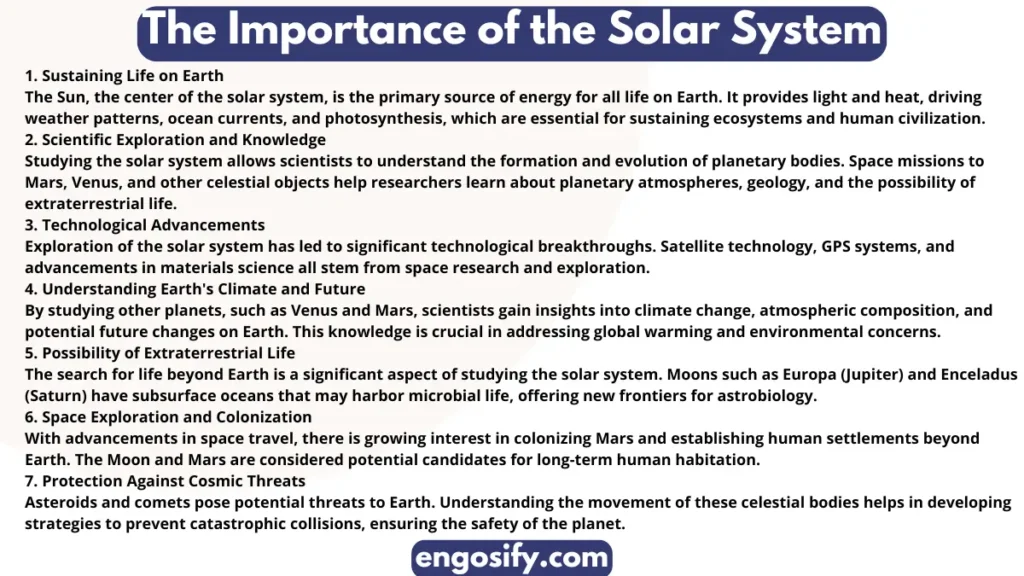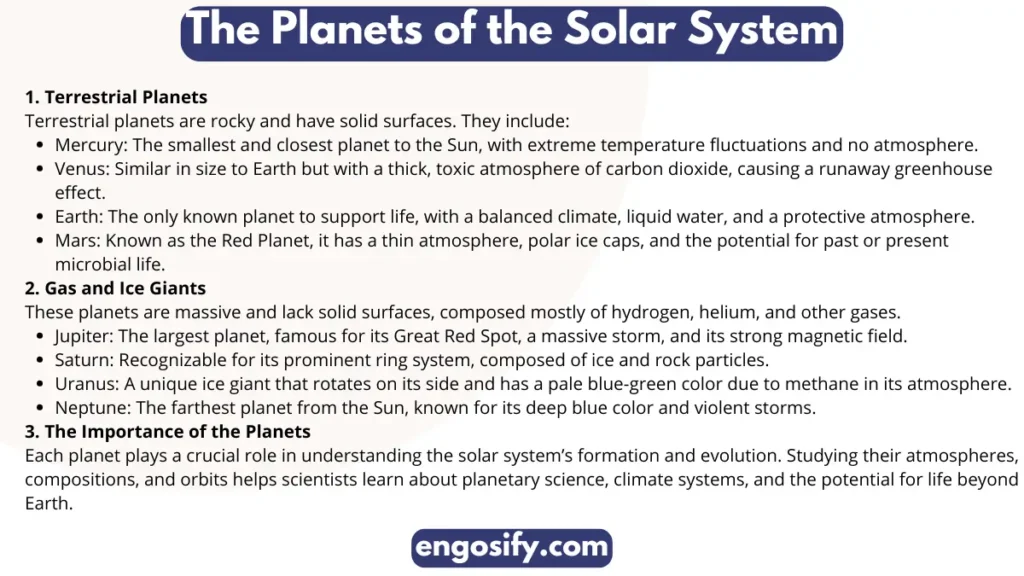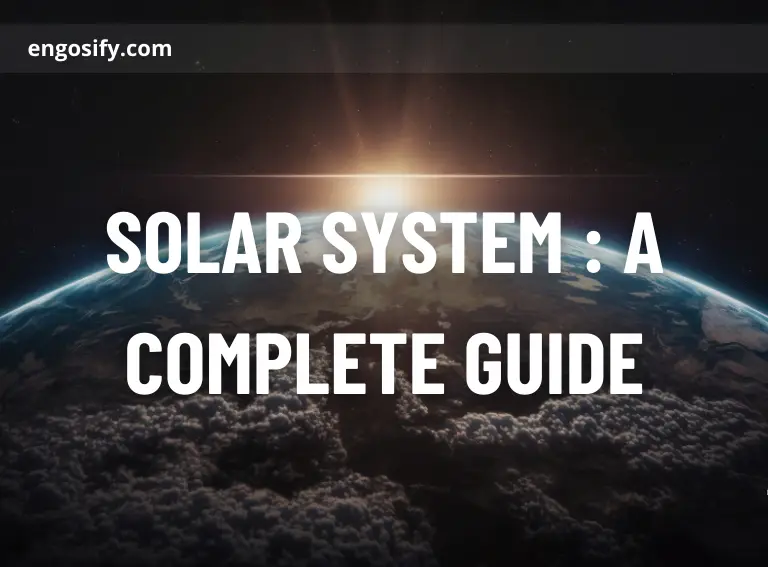Look up at the night sky, and what do you see? A mesmerizing dance of celestial bodies, all part of our vast solar system. But have you ever wondered how it all began? How the planets, moons, and even the tiniest asteroids came to be? Understanding the solar system is like unraveling the mysteries of the universe itself. From its fiery birth to its ongoing evolution, every cosmic body has a story to tell. This comprehensive guide will take you on an exciting journey through the solar system, exploring its formation, structure, and fascinating celestial objects. Buckle up—because space is about to get a whole lot more interesting!
Introduction to the Solar System
What is the Solar System?
The solar system is our cosmic neighborhood, a vast expanse of space dominated by the Sun at its center. It consists of eight planets, their moons, dwarf planets, asteroids, comets, and countless other celestial objects. Bound together by gravity, this intricate system orbits the Sun, creating the dynamic universe we observe today.
The Importance of the Solar System
Why does the solar system matter? Well, for starters, it’s home to Earth—the only known planet to support life. But beyond that, studying our solar system helps us understand planetary formation, space exploration, and even the possibilities of extraterrestrial life. Scientists constantly study planetary movements, solar activity, and cosmic interactions to unlock secrets about our universe.
Major Components of the Solar System
Let’s break down the key components of the solar system:
- The Sun: A massive ball of burning plasma that provides heat and light.
- Planets: Mercury, Venus, Earth, Mars, Jupiter, Saturn, Uranus, and Neptune—each unique in its composition and characteristics.
- Dwarf Planets: Smaller celestial bodies like Pluto and Eris that don’t quite fit the traditional planet definition.
- Asteroids and Comets: Space rocks and icy objects that travel through the system, sometimes on collision courses.
- Moons: Natural satellites that orbit planets, with Earth’s Moon being the most well-known.
Fun Fact: How Big is the Solar System?
It’s enormous! The solar system stretches over 287.46 billion kilometers (179 billion miles) from the Sun to the farthest known object in the Oort Cloud. That’s about 2,000 times the distance from Earth to the Sun!
How Do We Explore the Solar System?
From early telescopes to modern spacecraft, humans have always been fascinated by space. Missions like Voyager 1, Curiosity Rover, and Hubble Space Telescope have provided breathtaking insights into the vastness of our solar system. Today, space agencies like NASA and ESA continue to push the boundaries of exploration, sending new missions to explore planets, moons, and beyond.

The Formation of the Solar System
How Did the Solar System Form?
The origins of our solar system date back 4.6 billion years to a massive cloud of gas and dust known as the solar nebula. Scientists believe that a nearby supernova explosion triggered the collapse of this nebula, leading to the birth of the Sun and the planets.
The Role of the Solar Nebula
As the nebula collapsed under gravity, it began to spin, flattening into a protoplanetary disk. At the center of this disk, intense pressure and heat ignited nuclear fusion, giving birth to the Sun. Meanwhile, particles in the outer regions of the disk clumped together, eventually forming planets, moons, and other celestial bodies.
Planetary Accretion: The Building Blocks of Planets
The formation of planets occurred through a process called accretion, where dust and rock particles stuck together to form larger bodies known as planetesimals. Over millions of years, these planetesimals merged through collisions, eventually forming the planets we know today.
Why Are There Two Types of Planets?
One of the most fascinating aspects of our solar system is the clear distinction between terrestrial planets and gas giants:
- Terrestrial Planets (Mercury, Venus, Earth, Mars): These rocky planets formed closer to the Sun, where heat prevented gases from condensing.
- Gas Giants and Ice Giants (Jupiter, Saturn, Uranus, Neptune): These massive planets formed farther from the Sun, where it was cold enough for gases like hydrogen and helium to accumulate.
The Early Chaos: Collisions and Catastrophes
The early solar system was a chaotic place, with frequent collisions between planetesimals. Some of these impacts had dramatic effects:
- The Moon is thought to have formed when a Mars-sized object collided with Earth.
- Mercury lost much of its outer layer due to a massive impact.
- Asteroid and comet collisions played a role in shaping planetary surfaces and possibly delivering water to Earth.
The Late Heavy Bombardment
Around 4 billion years ago, a period known as the Late Heavy Bombardment occurred. During this time, a surge of asteroids and comets bombarded planets and moons, leaving behind craters still visible today—like those on the Moon and Mercury.
The Solar System Settles Down
After millions of years of violent collisions and planetary migrations, the solar system finally settled into its current structure. The Sun stabilized, planets established their orbits, and moons formed around larger celestial bodies.
The Sun – The Heart of Our Solar System
The Sun’s Role in the Solar System
The Sun is the powerhouse of our solar system. As a G-type main-sequence star (G2V), it provides the energy necessary for life on Earth and influences planetary climates, atmospheres, and orbits. Without the Sun’s gravity, the entire solar system would drift apart into space.
The Composition of the Sun
The Sun is primarily composed of hydrogen (about 74%) and helium (about 24%), with traces of heavier elements. Its intense gravitational pressure enables nuclear fusion, converting hydrogen into helium and releasing an enormous amount of energy.
Layers of the Sun
The Sun consists of several layers, each with distinct properties:
- Core: The hottest region, where nuclear fusion occurs, reaching temperatures of 15 million°C (27 million°F).
- Radiative Zone: Energy slowly moves outward through this layer over thousands of years.
- Convective Zone: Hot gases rise and cooler gases sink, creating convection currents.
- Photosphere: The visible surface of the Sun, emitting light and heat.
- Chromosphere and Corona: The outer layers, visible during solar eclipses, releasing solar winds and charged particles into space.
Solar Activity and Its Effects on Earth
The Sun’s activity is not constant—it undergoes an 11-year solar cycle, affecting sunspots, solar flares, and coronal mass ejections (CMEs). These solar storms can impact Earth’s communication systems, satellites, and even power grids.
The Planets of the Solar System
The Inner Planets: Rocky Worlds
- Mercury – The smallest planet, closest to the Sun, with extreme temperatures.
- Venus – Earth’s “twin” with a thick, toxic atmosphere and runaway greenhouse effect.
- Earth – The only planet known to support life, with vast oceans and diverse ecosystems.
- Mars – The “Red Planet,” known for its dust storms and potential for past water.
The Outer Planets: Gas and Ice Giants
- Jupiter – The largest planet, famous for its Great Red Spot and powerful storms.
- Saturn – Known for its stunning ring system and numerous moons.
- Uranus – Rotates on its side and has a blue-green hue due to methane.
- Neptune – The farthest planet, with strong winds and the dark storm spots.
Dwarf Planets and Small Solar System Bodies
Dwarf planets are celestial objects that share characteristics with planets but fail to clear their orbits of other debris. The most well-known dwarf planet is Pluto, but others include:
- Eris – Slightly smaller than Pluto but much more massive.
- Haumea – Known for its elongated shape and rapid rotation.
- Makemake – A cold, icy world beyond Pluto.
- Ceres – The largest object in the asteroid belt, sometimes considered both a dwarf planet and an asteroid.
Asteroids: The Space Rocks of the Solar System
Asteroids are remnants from the early solar system, mostly found in the asteroid belt between Mars and Jupiter. Some notable ones include:
- Vesta – One of the largest and brightest asteroids.
- Pallas – A unique, irregularly shaped asteroid.
- Eros – The first asteroid ever visited by a spacecraft.
Comets: The Ice Travelers
Comets are icy bodies that develop tails when they approach the Sun. Famous examples include:
- Halley’s Comet – Visible from Earth every 76 years.
- Comet NEOWISE – One of the most recent bright comets visible in 2020.
Moons of the Solar System
What Are Moons?
Moons, also known as natural satellites, are celestial bodies that orbit planets and even some dwarf planets. These fascinating objects vary in size, composition, and origin, playing a crucial role in shaping planetary systems. Some moons formed from the same disk of dust and gas as their parent planets, while others were captured by a planet’s gravitational pull.
Notable Moons in the Solar System
Earth’s Moon: Our Closest Neighbor
Earth’s Moon is the fifth-largest moon in the solar system. It plays a vital role in stabilizing Earth’s rotation, influencing ocean tides, and even affecting our planet’s climate. Scientists believe the Moon formed from a colossal impact between Earth and a Mars-sized body called Theia around 4.5 billion years ago.
The Moons of Mars: Phobos and Deimos
Mars has two small, irregularly shaped moons:
- Phobos – The larger of the two, moving closer to Mars over time. Scientists predict it will eventually crash into the planet.
- Deimos – Smaller and farther away, with a smoother surface.
Both are thought to be captured asteroids from the asteroid belt.
Jupiter’s Galilean Moons: A Mini Solar System
Jupiter, the largest planet, boasts 79 moons, but the most famous are the four Galilean moons, discovered by Galileo in 1610:
- Io – The most volcanically active body in the solar system.
- Europa – An icy world with a subsurface ocean that may harbor alien life.
- Ganymede – The largest moon in the solar system, even bigger than Mercury.
- Callisto – A heavily cratered moon, possibly hiding an underground ocean.
Saturn’s Diverse Moons
Saturn has 83 known moons, each unique in its own way:
- Titan – The second-largest moon in the solar system, with lakes of liquid methane and an atmosphere thicker than Earth’s.
- Enceladus – An icy moon with geysers that spew water vapor into space, hinting at an underground ocean.
- Mimas – Known as the “Death Star Moon” due to its massive Herschel Crater.

Uranus and Neptune’s Moons
- Uranus has 27 moons, the largest being Titania and Oberon, named after characters from Shakespeare’s plays.
- Neptune’s Triton is one of the coldest objects in the solar system, with geysers that erupt nitrogen gas. It orbits in the opposite direction of Neptune’s rotation, suggesting it was captured from the Kuiper Belt.
Dwarf Planets and Their Moons
Even dwarf planets have moons! Pluto has five known moons, with Charon being the largest—so big that Pluto and Charon orbit each other like a double planet.
Why Are Moons Important?
Moons help stabilize planetary orbits, drive geological activity, and may even contain conditions suitable for life. Space agencies like NASA and ESA are planning missions to explore moons like Europa and Titan, hoping to uncover the secrets of our solar system.
The Outer Edges of the Solar System
Beyond Neptune: The Mysterious Outer Regions
The solar system doesn’t end with Neptune. In fact, beyond the last planet lies a vast, mysterious region filled with icy bodies, dwarf planets, and possibly even undiscovered worlds. Scientists are still exploring these distant frontiers, hoping to unlock secrets about the origins of our cosmic neighborhood.
The Kuiper Belt: A Second Asteroid Belt
The Kuiper Belt is a massive ring of icy objects beyond Neptune, extending from 30 to 55 AU (astronomical units) from the Sun. This region is similar to the asteroid belt but contains more frozen bodies made of ice and rock. Some well-known Kuiper Belt Objects (KBOs) include:
- Pluto – Once the ninth planet, now classified as a dwarf planet.
- Eris – Slightly smaller than Pluto but with more mass.
- Haumea – An elongated, fast-spinning dwarf planet.
- Makemake – A reddish, icy world with an extremely cold surface.
The Oort Cloud: The Solar System’s Edge
Even farther out lies the Oort Cloud, a hypothetical sphere of icy objects that marks the boundary of the solar system. It is believed to stretch up to 100,000 AU from the Sun! This distant region is thought to be the birthplace of long-period comets, such as Halley’s Comet.
The Search for Planet Nine
Scientists suspect that a massive, yet unseen, planet—nicknamed Planet Nine—lurks in the outer solar system. Its presence is inferred from the unusual orbits of distant Kuiper Belt objects, but no direct evidence has been found yet. If it exists, Planet Nine could be several times the size of Earth!
Interstellar Space: Where the Solar System Ends
At some point, the Sun’s influence fades, and interstellar space begins. The boundary between these two realms is called the heliopause, where the solar wind meets the winds from other stars. NASA’s Voyager 1 and Voyager 2 spacecraft have both crossed this threshold, making them the first human-made objects to enter interstellar space!
FAQs
What is the solar system?
The solar system is a collection of celestial bodies, including the Sun, eight planets, their moons, dwarf planets, asteroids, comets, and other space objects, all bound by the Sun’s gravity.
How old is the solar system?
The solar system is estimated to be 4.6 billion years old, formed from a giant cloud of gas and dust known as the solar nebula.
How many planets are in the solar system?
There are eight planets in the solar system:
- Terrestrial Planets: Mercury, Venus, Earth, Mars
- Gas Giants: Jupiter, Saturn
- Ice Giants: Uranus, Neptune
Why isn’t Pluto considered a planet anymore?
In 2006, the International Astronomical Union (IAU) redefined what makes a planet. Pluto failed to meet the criteria because it hasn’t cleared its orbit of other debris, so it was reclassified as a dwarf planet.
Conclusion
The solar system is a breathtaking and ever-evolving cosmic wonder, filled with planets, moons, asteroids, and countless mysteries waiting to be uncovered. From its fiery birth in a swirling solar nebula to the incredible celestial bodies that orbit our Sun, every part of this vast system tells a unique story of formation, evolution, and discovery.
As humanity continues to push the boundaries of space exploration, missions like Perseverance, Voyager, and upcoming lunar and Martian endeavors promise to unlock even more secrets about our cosmic neighborhood. Who knows? Future generations may one day travel beyond the solar system, reaching new frontiers in interstellar space.
The journey of discovery never ends—so keep looking up, stay curious, and explore the wonders of the solar system and beyond! 🚀✨

